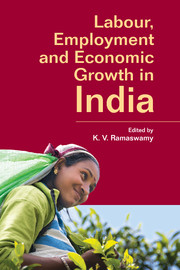Book contents
- Frontmatter
- Dedication
- Contents
- List of Tables and Figures
- Preface
- Part 1 Economic Growth and Employment
- 1 Introduction and Review of Issues
- 2 India's Labour Market during the 2000s
- 3 Services-led Growth and Employment in India
- 4 Growth, Structural Change and Poverty Reduction
- 5 Age Structure Transition, Population Ageing and Economic Growth
- 6 Labour Intensity in Indian Manufacturing
- 7 Gender Discrimination in Manufacturing Employment in India, 1999-2009
- Part 2 Employment and Labour Law
- Contributors
- Index
1 - Introduction and Review of Issues
from Part 1 - Economic Growth and Employment
Published online by Cambridge University Press: 05 June 2015
- Frontmatter
- Dedication
- Contents
- List of Tables and Figures
- Preface
- Part 1 Economic Growth and Employment
- 1 Introduction and Review of Issues
- 2 India's Labour Market during the 2000s
- 3 Services-led Growth and Employment in India
- 4 Growth, Structural Change and Poverty Reduction
- 5 Age Structure Transition, Population Ageing and Economic Growth
- 6 Labour Intensity in Indian Manufacturing
- 7 Gender Discrimination in Manufacturing Employment in India, 1999-2009
- Part 2 Employment and Labour Law
- Contributors
- Index
Summary
India's transition to an economy capable of high growth in the years since 1980 has been of global interest, discussion and research. The metaphor of an elephant to describe Indian economy muddling through gave way to that of a tiger unchanged in the 1990s. The Gross Domestic Product (GDP) per capita grew annually by an average of 1.2 per cent in the 1960s and 1970s but this growth rate changed to an average of 3.5 per cent in the 1980s, 3.7 per cent in the 1990s and 5.5 per cent in the 2000s. India has transformed itself to be counted among the fastest growing economies in the world with an average GDP per capita growth rate of 3.7 per cent in the years 1980 to 2004. In terms of GDP growth performance alone one finds that Indian economy's average annual growth rate was 3.5 per cent during 1951–82 (euphemistically called the Hindu Rate of Growth) that increased to 5.4 percent in the next two decades (1983–99) followed by a growth rate of above 7 per cent in the 2000s. The causes and outcomes of this economic transformation have been the subject of research and analysis in recent years. A perceptive analytical assessment of the evidence and factors driving change is available in Kotwal, Ramaswami and Wadhwa (2011). The economic policy reform of 1991 has played an important role in driving this growth but other pre-existing factors have also influenced the pattern of development (Kochhar, et al., 2006). First and perhaps the foremost feature of India's growth experience is that it is led by services sector unlike in other countries of East Asia and China. In the broader context of economic development and structural change, the observed sequence was that manufacturing followed agriculture while the service sector became prominent only at later stage. India's experience appeared to be different with the share of services sector in GDP sharply going up in the 1990s, beginning with a share of 43 per cent in 1990–91, to reach a high share of 57 per cent in 2009–10.
- Type
- Chapter
- Information
- Labour, Employment and Economic Growth in India , pp. 3 - 20Publisher: Cambridge University PressPrint publication year: 2015
- 2
- Cited by



